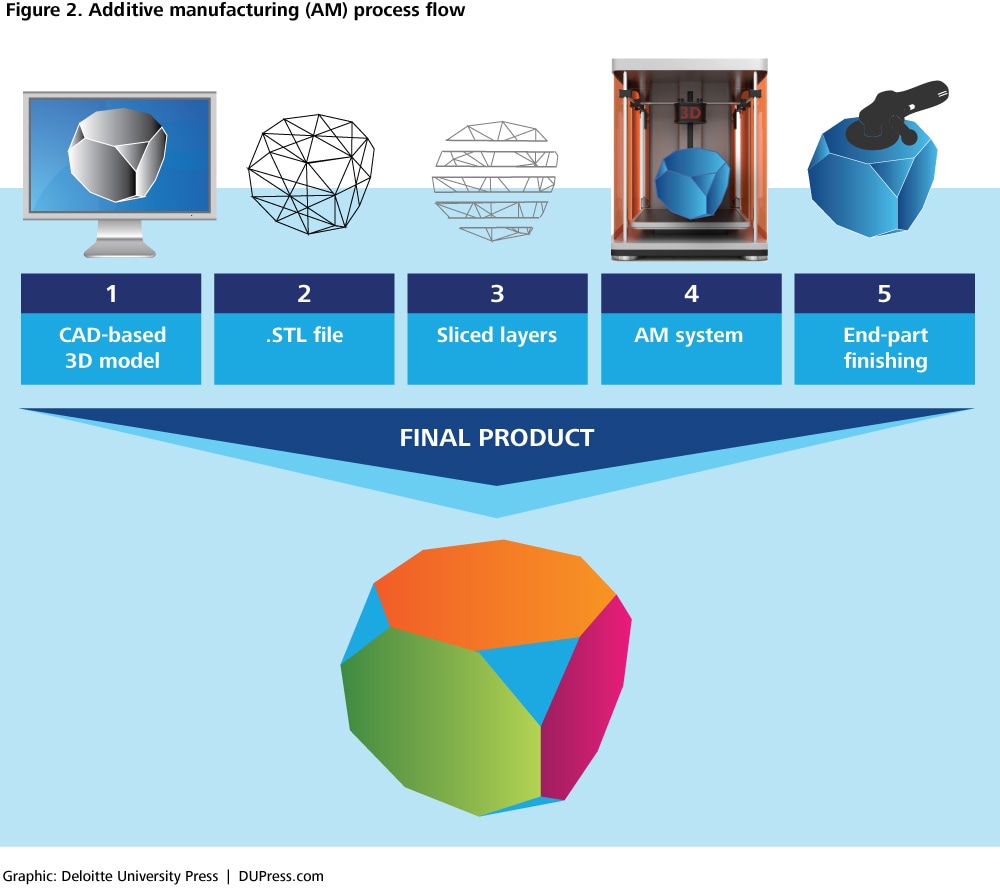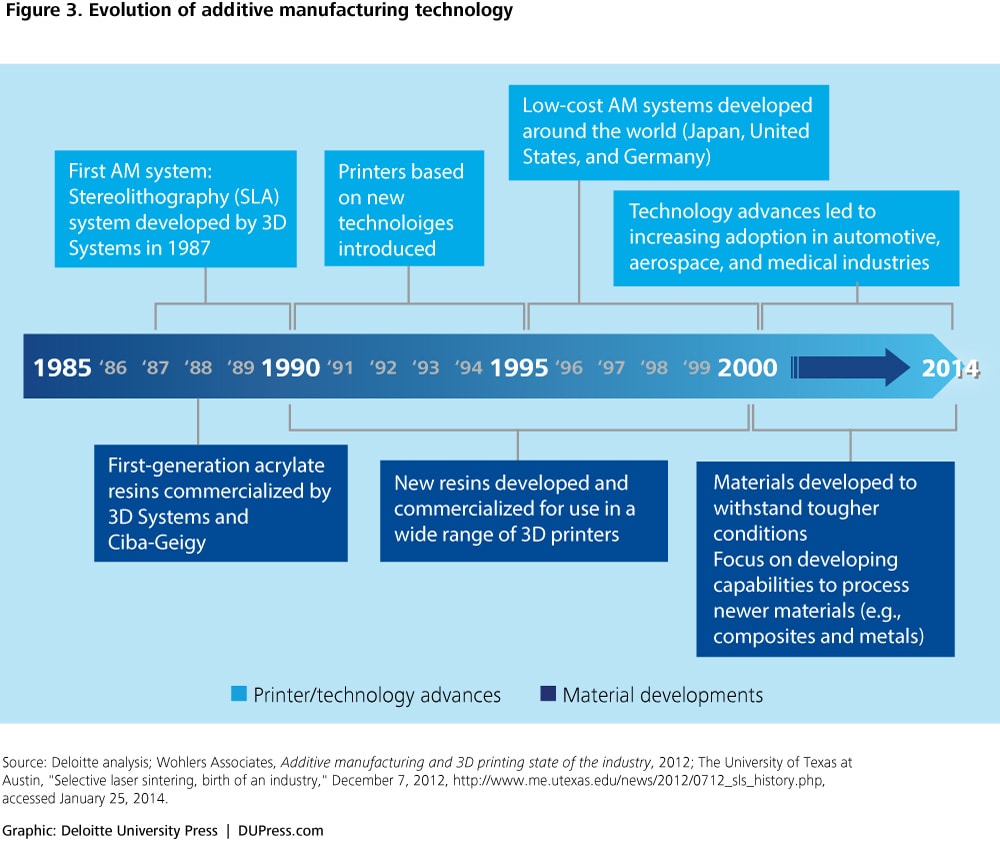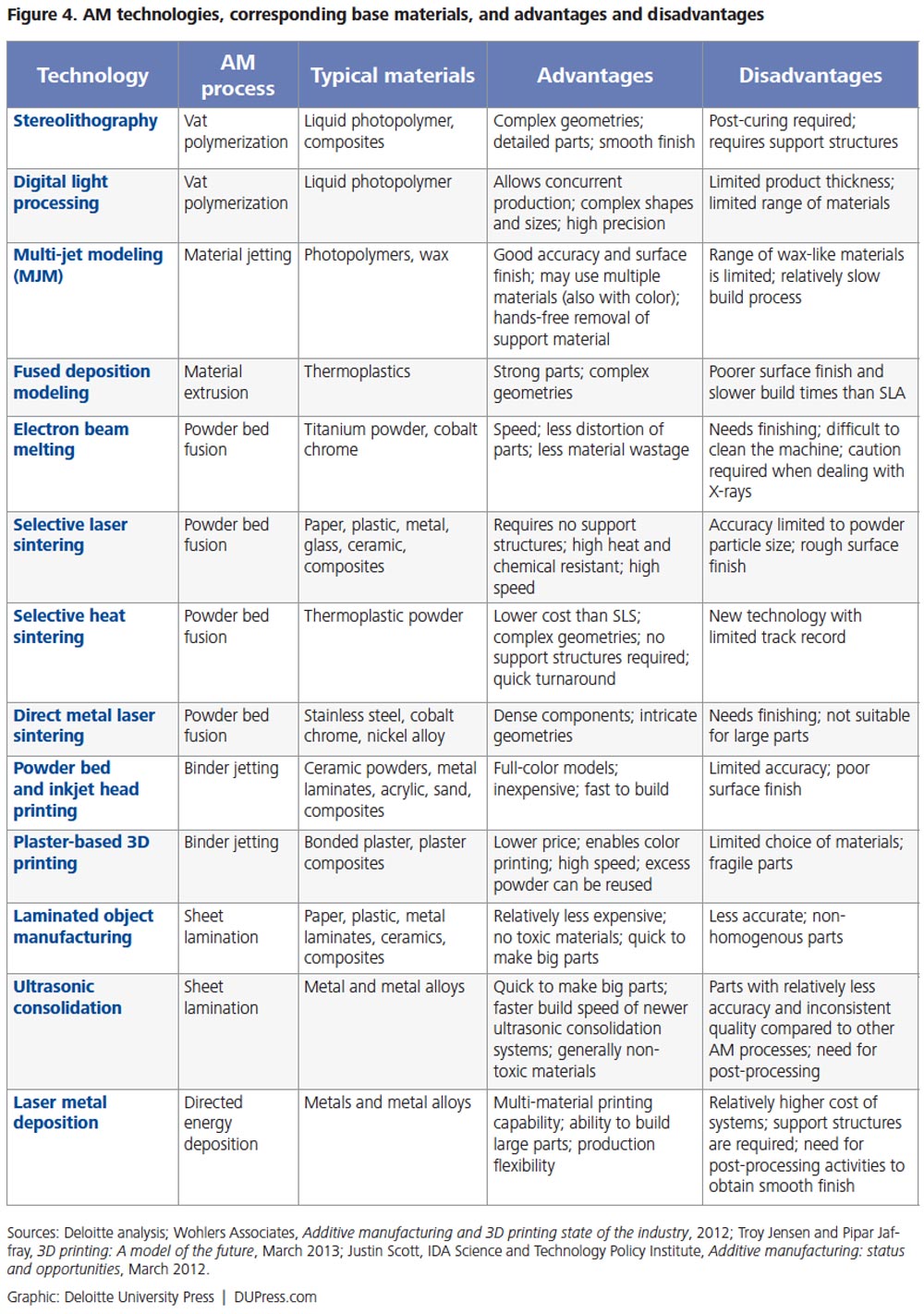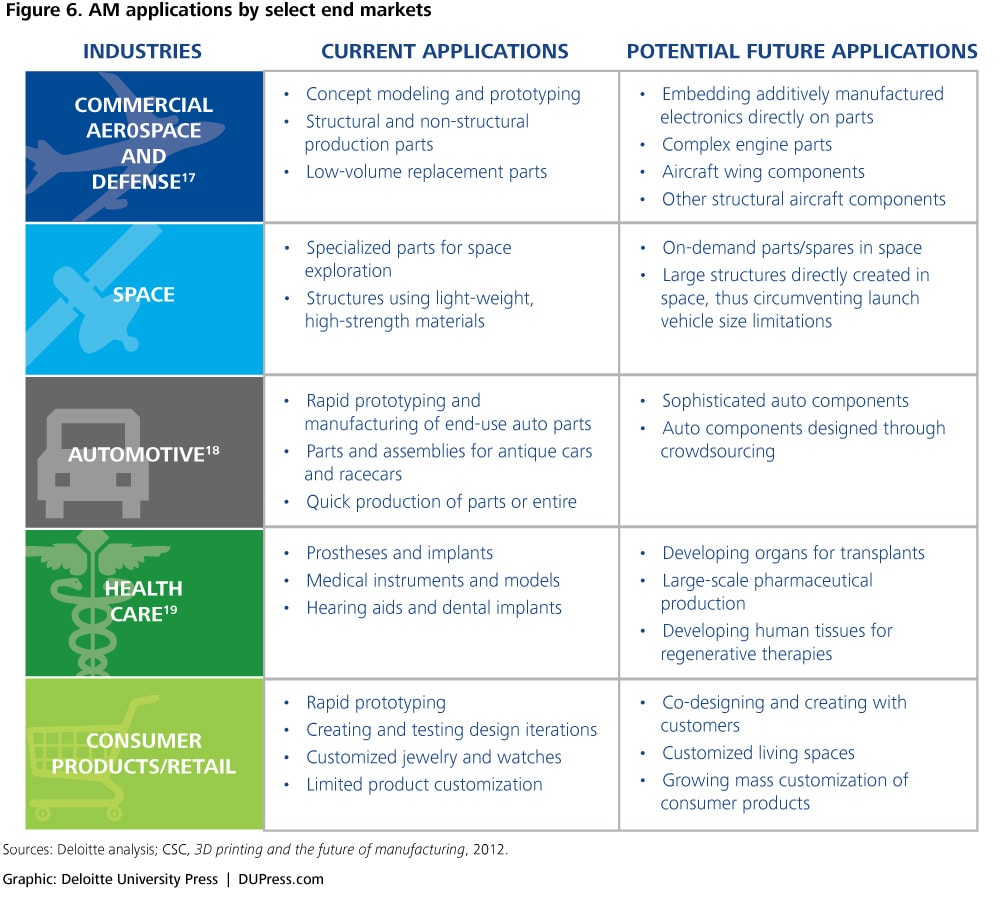The 3D opportunity primer has been saved

The 3D opportunity primer The basics of additive manufacturing
07 March 2014
If the past is prologue, the role that additive manufacturing plays in the manufacturing value chain will likely grow in scope, scale, and complexity.
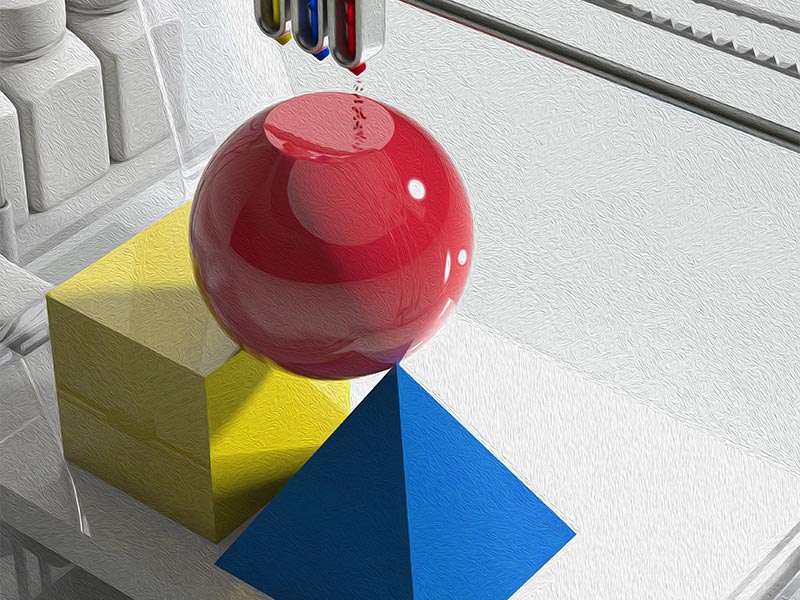
Want to learn more about 3D printing?
Visit the 3D Opportunity collection
Register for our upcoming course
Learn how additive manufacturing can transform your organization.
Foreword
Additive manufacturing (AM), also known as 3D printing, refers to a group of technologies that create products through the addition of materials (typically layer by layer) rather than by subtraction (through machining or other types of processing).
The history of AM traces back over 30 years to 1983 and the invention of stereolithography. Since then, the technology has evolved to include at least 13 different sub-technologies grouped into seven distinct process types.
We hope this report serves as a useful primer for managers seeking to develop a basic understanding of the different technologies and processes that fall under the AM umbrella. Although not exhaustive (as the technologies are constantly evolving), we believe this report offers a thorough survey to facilitate enlightened discussion by companies interested in the AM topic.
To help readers appreciate how AM can aid their companies’ performance, growth, and innovation goals, we offer a detailed framework in our report 3D opportunity: Additive manufacturing paths to performance, innovation, and growth, available on Deloitte University Press.1 We also offer specific insights for key industries: 3D opportunity for aerospace and defense: Additive manufacturing takes flight (http://dupress.com/articles/additive-manufacturing-3d-opportunity-in-aerospace/); 3D opportunity for the automotive industry: Additive manufacturing hits the road (http://dupress.com/articles/additive-manufacturing-3d-opportunity-in-automotive/); and 3D opportunity in medical technology: Additive manufacturing comes to life (http://dupress.com/articles/additive-manufacturing-3d-opportunity-in-medtech/). For a complete catalog of material available from Deloitte on additive manufacturing, please see http://dupress.com/collection/3d-opportunity/.
An overview of additive manufacturing (3D printing)
Additive manufacturing (AM) defined
Additive manufacturing (AM) refers to a set of technologies and processes that have been developed over more than 30 years. ASTM International, a global body recognized for the development and delivery of consensus standards within the manufacturing industry, defines additive manufacturing as:
“A process of joining materials to make objects from 3D model data, usually layer upon layer, as opposed to subtractive manufacturing methodologies.2”
In common practice, the terms “AM” and “3D printing” are used interchangeably.3
AM process flow: Layer-by-layer additive process
The AM process traditionally begins with the creation of a three-dimensional (3D) model through the use of computer-aided design (CAD) software. The CAD-based 3D model is typically saved as a standard tessellation language (.STL) file, which is a triangulated representation of the model. Software then slices the data file into individual layers, which are sent as instructions to the AM device. The AM device creates the object by adding layers of material, one on top of the other, until the physical object is created. Once the object is created, a variety of finishing activities may be required. Depending on the material used and the complexity of the product, some parts may need secondary processing, which can include sanding, filing, polishing, curing, material fill, or painting. Figure 1 depicts a selection of items manufactured using AM. Figure 2 depicts the overall AM process.
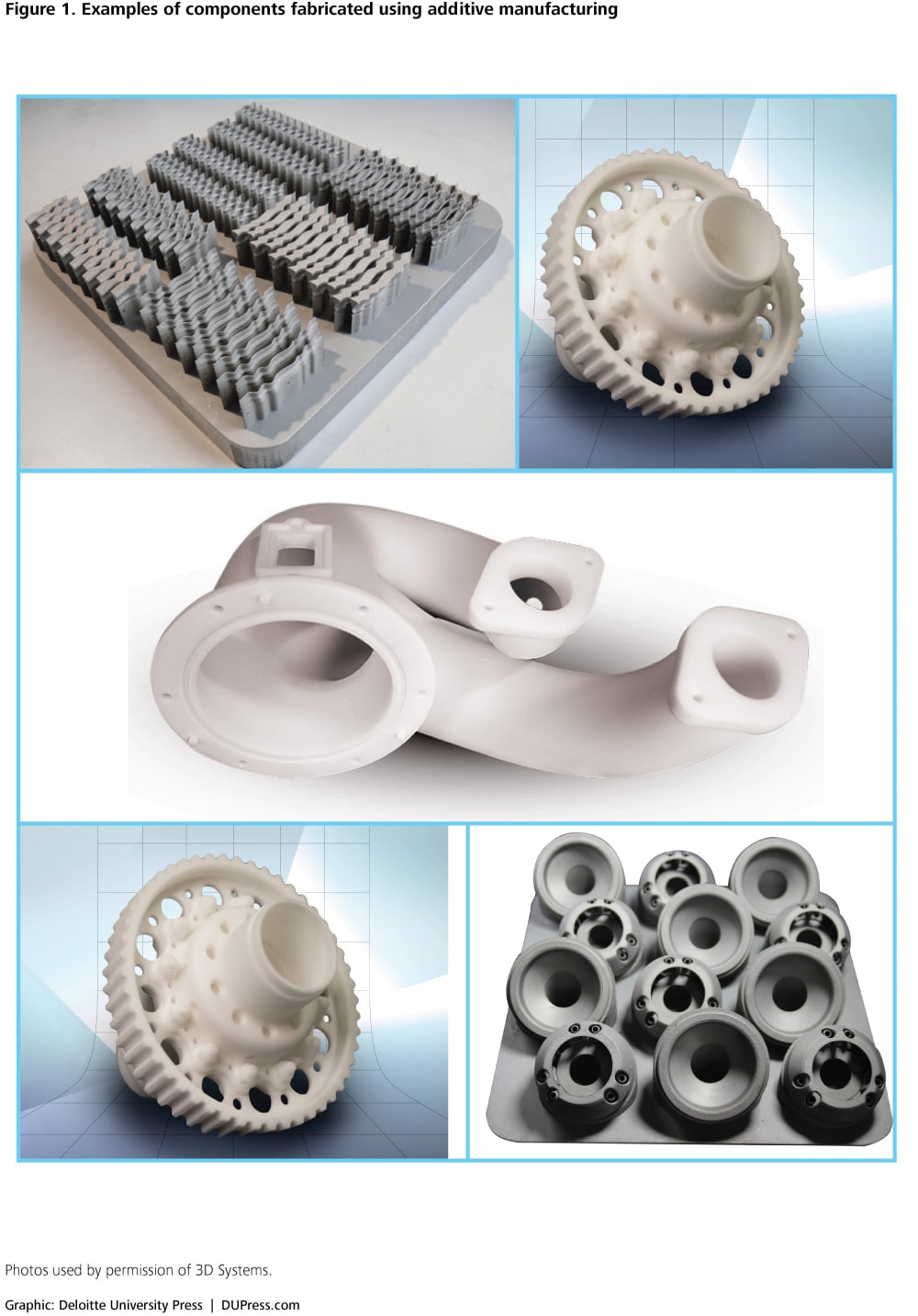
Sophisticated 3D scanning and imaging tools are emerging as alternatives for traditional CAD programs. In addition, stylus-based and other design technologies that allow consumers to modify digital models themselves—without the need for extensive CAD experience—are expected to drive growth in the personal AM systems space. New formats, such as additive manufacturing file format (AMF), are also being developed to address .STL’s limitations and allow for more flexible file structures.
History of additive manufacturing: Industry adoption accelerates in the past decade
AM has its earliest roots in research activities from the fields of topography and photosculpture during the 19th century. The first successful attempts at AM derived from technology developed in the 1970s.4AM first approached commercial viability in 1983 when Charles Hull invented stereolithography, enabling a 3D object to be printed from CAD data.5 In 1986, Hull co-founded 3D Systems, Inc., the first company to commercialize AM technology with the stereolithography (SLA) apparatus.6Selective laser sintering (SLS), another AM technology, was first commercialized in the late 1990s; just like SLA, its applications grew from prototyping to end-part production over the years, driven by lower system costs.7
AM processes were largely geared toward prototyping applications in the 1990s. However, since the late 1990s, AM technologies and processes have increasingly been deployed to large-scale industrial, medical, and consumer end-market applications. Significant developments since the early 2000s include AM applications in the production of parts for unmanned aircraft, automobiles, consumer products, and organ and tissue printing systems.8 As shown in figure 3, AM technology continues to improve in the speed of processing, the complexity of design, and the variety of materials used.
AM versus traditional manufacturing: Understanding trade-offs
AM creates 3D structures by adding materials layer upon layer. In contrast, traditional manufacturing practices (such as drilling or machining) are often “subtractive,” as they remove material from areas where it is not desired. Additive manufacturing and traditional manufacturing face different trade-offs, with each process likely to play a role in the deployment of manufacturing capabilities.
Below, we list some of the respective advantages of AM and traditional manufacturing.
Advantages of AM
- Design complexity: AM enables the creation of intricate designs to precise dimensions that are difficult or impossible to create using traditional methods.
- Speed to market: AM systems can manufacture products with little or no tooling, saving time during product design and development and enabling on-demand manufacturing.
- Waste reduction: AM typically uses less extraneous material when manufacturing components, thus significantly reducing or eliminating scrap and waste during production. This makes AM a more efficient process.
Advantages of traditional manufacturing
- Mass production: Traditional manufacturing is well-suited for high-volume production where fixed tooling and setup costs can be amortized over a larger number of units. Additive manufacturing is generally more competitive for low-to-medium volume production runs.
- Choice of materials: Traditional manufacturing techniques can be deployed to a wide variety of materials, while additive manufacturing predominantly uses a narrower range of polymers, metals, ceramics and composites.
- Manufacturing large parts: Compared with AM systems, which are constrained by the envelope sizes currently available, traditional machining is better suited to manufacturing large parts.
Overall, AM offers companies an array of time efficiencies and cost reductions throughout the product lifecycle and supply chain, as well as greater flexibility in design and product customization than traditional manufacturing. These benefits will likely drive increasing levels of AM adoption going forward. Two key areas of benefit include:
- Workflow streamlining: AM can reduce prototype development time and shorten review cycles. Since AM processes are viewed as generating less scrap and using fewer tools, materials, and parts than traditional manufacturing—as well as reduced assembly and inventory demands—substantial cost benefits can be anticipated.
- Flexible design and product customization: AM processes offer rapid iteration of designs and enable low-volume print-on-demand applications. The ability to engage and influence the customer experience through custom, same-day production may have ramifications in consumer and industrial products end markets.
AM processes, technologies, and applications
Functional prototypes and end-use parts built through AM technologies have wide applications in industries such as industrial & consumer products, automotive, medical, and aerospace. AM technologies use a variety of materials, including plastics, metals, ceramics, and composites, and deploy multiple different processes to address issues such as design complexity, surface finish, unit cost, speed of operations, and others. To meet diverse requirements, industrial-grade AM systems are available in the market ranging in cost from less than $10,000 to $1 million—and more.9
AM technologies are typically based on one of the seven primary manufacturing processes described below.10 The major AM processes and technologies can be characterized by the materials they use and the advantages and disadvantages they offer (figure 4).11
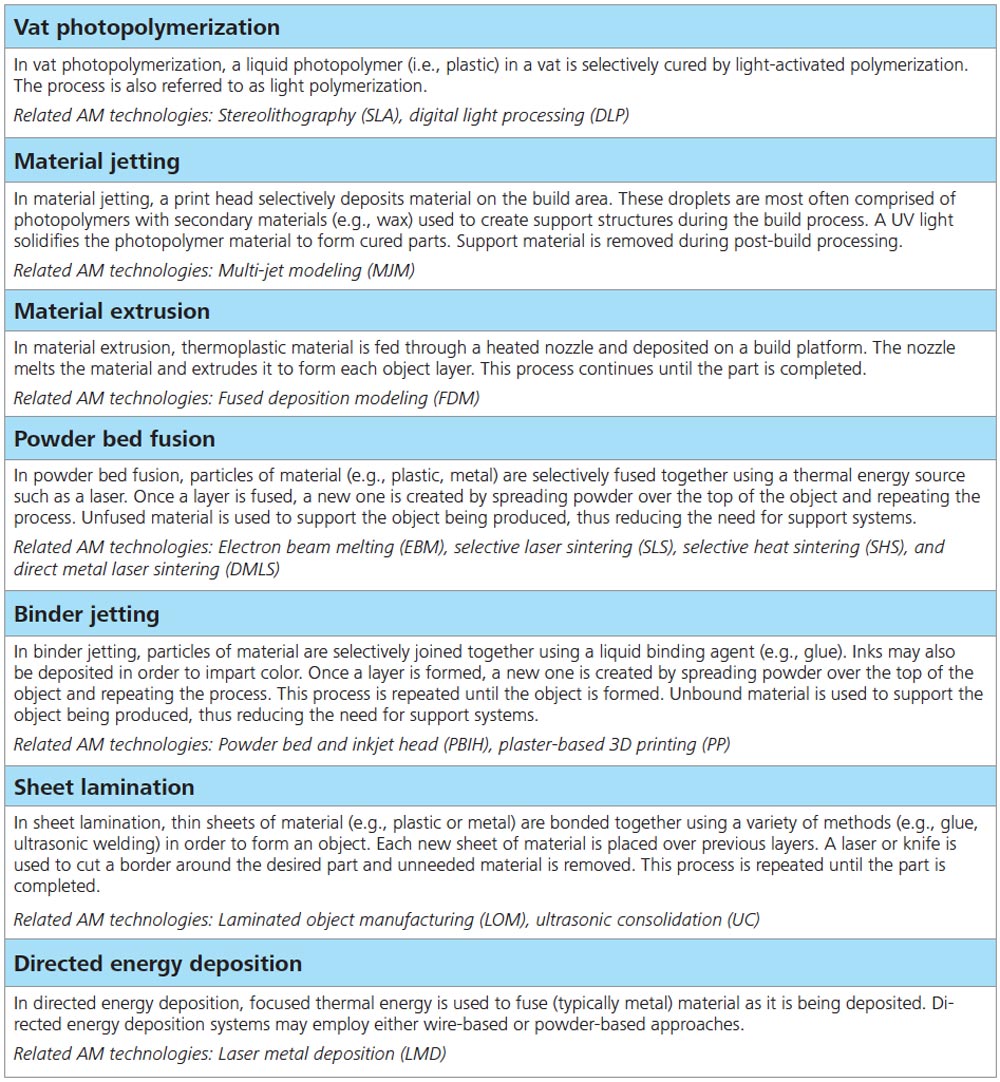
AM technologies use a range of materials. A classification of these materials into broad categories (figure 5) reveals that materials such as polymers and metals are widely used in AM systems. To a lesser extent, ceramics and composites also support AM processes. Use of varied materials in AM is an area of focus for R&D in the future.
AM applications: The technology’s inherent benefits will drive increasing penetration across industries in the next decade
Application of AM technologies is expected to grow across industries as increasing numbers of companies use the technology not just for producing prototypes, but to manufacture parts and full-scale products.15 The technology will act as a particularly strong catalyst for substantive research developments in the health care and manufacturing industries.16 Figure 6 summarizes some current applications of and potential future developments in AM in select industries. The breadth of current and likely future applications suggests that there is strong growth potential for AM going forward.
Market opportunities and challenges
In his 2013 State of the Union address, US President Barack Obama called for the creation of the National Additive Manufacturing Innovation Institute (now called America Makes), established and funded in part by the US government, to help revitalize the US manufacturing sector.20 AM has the potential to shift the US manufacturing paradigm in coming years; it can allow the United States to become self-sufficient as production becomes localized. Some experts have even heralded AM as the next great disruptive technology, similar to personal computing, giving everyone on the planet the ability to imagine, design, and create custom and personalized products.21Such exuberance should be tempered. Even as AM offers great potential, it also faces an array of challenges. Figure 7 offers a snapshot of key AM market opportunities as well as challenges; although not exhaustive, this list may serve as the basis for a more thorough examination of drivers and headwinds that may impact future developments in AM.

The way forward
Some believe that AM technology will continue to be used primarily for prototyping applications, due to its current inability to cost-effectively satisfy widespread manufacturing applications. Others believe that AM technology can revolutionize manufacturing processes. Regardless of one’s viewpoint, there is little doubt that the past 30 years have witnessed an unceasing advancement in AM system functionality, ease of use, cost, and adoption across multiple industrial sectors. There exists an unmistakable shift in the AM landscape—from relatively common prototyping and modeling applications toward emerging applications aimed at manufacturing direct parts and end products.
If the past is prologue, the role that AM technology plays in the manufacturing value chain will grow in scope, scale, and complexity. While there is still some time before AM realizes its full potential, companies should assess how AM can help advance their performance, growth, and innovation goals.
Deloitte offers several detailed perspectives on specific aspects of the AM technology domain. Interested readers are directed to Deloitte’s AM framework discussion in the article “3D opportunity: Additive manufacturing paths to performance, innovation, and growth,” available on Deloitte University Press and to the Deloitte University Press collection on additive manufacturing at www.dupress.com/3D-Opportunity.22
Deloitte Consulting LLP’s supply chain and manufacturing operations practice helps companies understand and address opportunities to apply advanced manufacturing technologies to impact their businesses’ performance, innovation, and growth. Our insights into additive manufacturing allow us to help organizations reassess their people, process, technology, and innovation strategies in light of this emerging set of technologies. Contact the author for more information or read more about our alliance with 3D Systems and our 3D Printing Discovery Center on www.deloitte.com.


